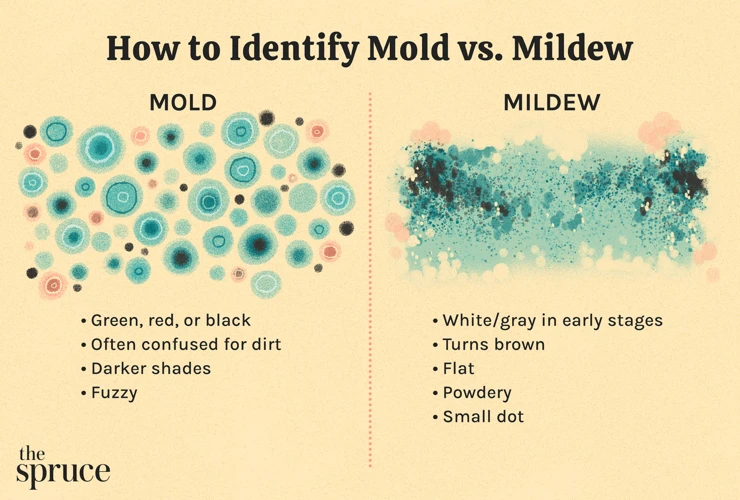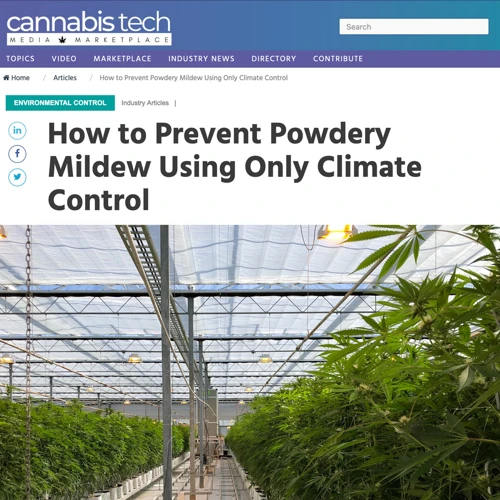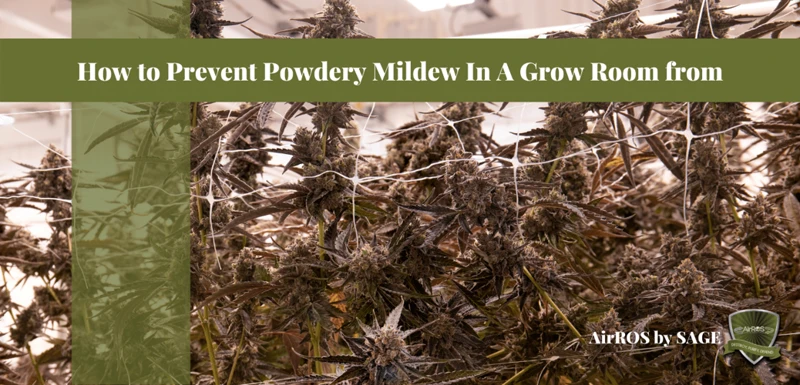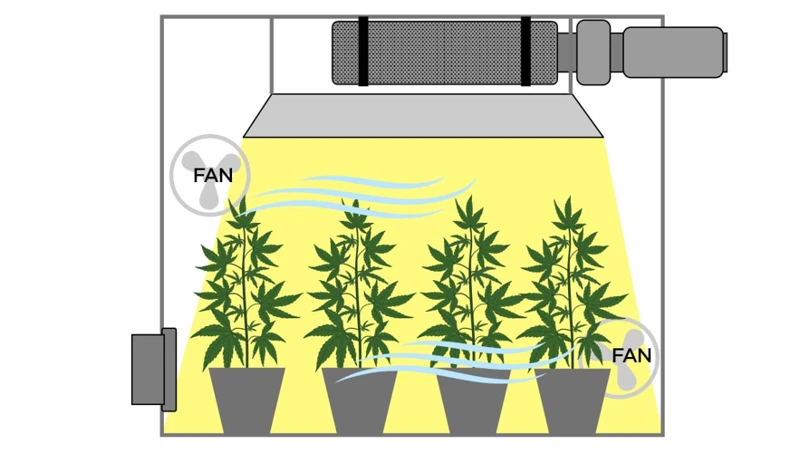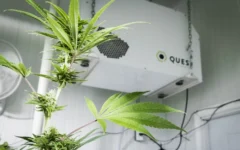
Preventing Mold and Mildew on Your Cannabis Plants
Growing cannabis can be a fulfilling and rewarding experience, but it also comes with its own set of challenges. One of the biggest obstacles that cannabis growers face is the threat of mold and mildew. These pesky intruders can destroy an entire crop and cause severe damage to your plants. However, there are steps you can take to avoid mold and mildew in your grow room. In this article, we will explore how regulating humidity can help prevent mold and mildew growth, maintaining cleanliness, choosing resistant strains, and the importance of proper air circulation. With these strategies, you will be able to grow healthy and mold-free cannabis plants.
Understanding Mold and Mildew
Contents
When it comes to growing cannabis, one of the most common and frustrating issues is the growth of mold and mildew. These pesky problems can quickly damage your plants and even render them unusable. To prevent this from happening, it’s essential to understand what mold and mildew are and why they pose a threat to your cannabis. By taking a closer look at these issues, you can better equip yourself to keep your grow room healthy and your plants thriving.
What are Mold and Mildew
Mold and mildew are types of fungi that can grow in damp and humid environments. They are commonly found in the air and can quickly spread to different surfaces. Mold and mildew can cause health issues and damage to property if not dealt with properly.
| Mold | Mildew |
|---|---|
| Mold is usually fuzzy or slimy in texture and can be a variety of colors, including black, green, or white. It reproduces through spores that can spread through the air and attach to surfaces. | Mildew is a type of mold that usually appears as a white or gray powdery substance. It grows on surfaces that are warm and humid, such as in bathrooms or kitchens. |
Both mold and mildew thrive in environments with high levels of moisture and can be difficult to completely remove once they have taken hold. It’s important for growers to understand how to prevent and control the growth of mold and mildew in order to protect their cannabis plants and maintain a healthy grow room environment.
Why are Mold and Mildew Bad for Cannabis
Mold and mildew are common problems in indoor cannabis cultivation that can have detrimental effects on the health and yield of your plants. They can thrive in warm, moist environments and can spread rapidly throughout your grow room if not taken care of immediately. Here are some reasons why mold and mildew are bad for cannabis:
- They can compromise the health of your plants – Mold and mildew can cause your cannabis plants to become weak and more susceptible to diseases and pests. They can also stunt growth and decrease yield, which can be disappointing for growers who are looking to have a successful harvest.
- They can affect the quality of your cannabis – Mold and mildew can produce toxins that can compromise the quality and potency of your cannabis buds. This can result in lower THC levels and unpleasant taste and smell.
- They can be harmful to human health – Certain types of mold can be harmful when inhaled, which can cause respiratory problems and allergic reactions. This can be dangerous for growers who spend a lot of time in the grow room.
In order to avoid these negative impacts, it’s important to keep your grow room regulated and clean to prevent the growth of mold and mildew. With the right humidity, air circulation, and strain selection, you can minimize the risk and ensure a successful cannabis harvest.
Controlling Humidity in Your Grow Room
Maintaining the perfect humidity levels in your grow room can be a perplexing task, but it’s vital for producing high-quality cannabis. Excessive moisture in the air can result in the growth of mold and mildew, leading to damaged crops and potentially harmful conditions for growers. To avoid these issues, it’s important to understand the ideal humidity for cannabis and how to monitor and adjust it. In this section, we’ll explore effective methods for controlling humidity in your grow room and ensuring the best possible growing environment for your plants.
Understand Ideal Humidity for Cannabis
Cannabis plants are very sensitive to humidity levels, so it’s crucial to understand what the ideal humidity for cannabis growth is. High humidity levels can lead to mold and mildew growth, while low humidity levels can result in the plants struggling to absorb nutrients and minerals from the soil.
The ideal humidity range for cannabis growth typically falls between 40-60% during the vegetative stage and 40-50% during the flowering stage. It’s essential to maintain these levels as fluctuations can damage the plants and impact overall yield.
To ensure that the plants thrive in the ideal humidity range, monitoring humidity levels is critical. Using a digital hygrometer, which measures the percentage of moisture in the air, can help in understanding the current humidity levels.
Additionally, it’s crucial to note that humidity levels can vary depending on the temperature in the grow room. For example, under high temperatures, humidity levels can increase, while under low temperatures, it can drop.
By understanding the ideal humidity range for cannabis growth and monitoring humidity levels, growers can regulate the environment to ensure healthy plant growth.
Monitor and Adjust Humidity
Maintaining proper humidity levels is essential to avoid mold and mildew growth in your cannabis grow room. To achieve this, you need to closely monitor and adjust humidity as necessary. Here are some tips on how to do that:
| Tip | Description |
|---|---|
| Invest in a hygrometer | A hygrometer is an essential tool for monitoring humidity levels in your grow room. Place it in a central location, away from any vents or fans that could affect the reading. Check the hygrometer regularly and record the readings. |
| Adjust humidity as needed | Based on the readings from your hygrometer, adjust the humidity levels in your grow room as needed. If the humidity is too high, use a dehumidifier to lower it. If it’s too low, use a humidifier or mist your plants. |
| Keep an eye on temperature | Temperature can also affect humidity levels. Make sure the temperature in your grow room is within the ideal range for cannabis, which is around 68-77°F (20-25°C). If the temperature is too high, it can cause the humidity to rise, so you may need to adjust both. |
| Check for leaks or drafts | Leaks or drafts can affect humidity levels in your grow room. Check for any gaps in windows or doors and seal them off. Make sure your ventilation system is properly sealed and not drawing in humid air from outside. |
By closely monitoring and adjusting the humidity levels in your grow room, you can ensure a healthy environment for your cannabis plants and avoid the growth of mold and mildew.
Invest in Dehumidifiers
Controlling the humidity in a grow room is crucial in preventing mold and mildew. One effective way to regulate humidity is by investing in dehumidifiers. Here are some reasons why dehumidifiers are beneficial:
- Prevents Mold and Mildew Growth: Dehumidifiers can help reduce excess moisture in the air, making it difficult for mold and mildew spores to thrive. This can prevent the spread of mold and mildew in the grow room and on cannabis plants.
- Improves Air Quality: Excess humidity can trap indoor pollutants such as dust and pet dander, causing poor air quality in the grow room. Dehumidifiers can reduce the moisture that traps these pollutants, improving the quality of air in the room.
- Protects Plants: High humidity levels can cause damage to plants, such as root rot and slowed growth. A dehumidifier can help prevent these issues by regulating the humidity levels and providing a healthy environment for the plants to grow.
- Increases Yield: By maintaining proper humidity levels with a dehumidifier, cannabis plants are able to reach their full potential in terms of yield and potency. When the air is too humid, plants can become stressed and produce smaller yields.
When choosing a dehumidifier, it is important to consider the size of the grow room and the capacity of the dehumidifier. A small dehumidifier may not be sufficient for a larger room, while a large dehumidifier may be too powerful for a smaller room. Additionally, consider the noise level of the dehumidifier, as it can be disruptive to plants and workers in the grow room.
Investing in a dehumidifier may seem like an added expense, but it can save the grower money in the long term by preventing mold and mildew growth and protecting the plants.
Maintaining a Clean Grow Room
As any cannabis grower knows, maintaining a sterile environment is crucial for the health and safety of your plants. However, the task of keeping a grow room clean and sanitized is often easier said than done. Pesky mold and mildew can quickly take over and ruin your crop, and overcrowding and overwatering can contribute to the problem. In this section, we will explore some tips and tricks for keeping your grow room free of harmful bacteria and fungus, and ensuring the health of your cannabis plants.
Keep Grow Room Clean and Sanitized
It is crucial to keep your grow room clean and sanitized to prevent the growth and spread of mold and mildew. Here are some tips on how to keep your grow room clean and sanitized:
- Regular Cleaning: Make it a habit to clean your grow room regularly. Use a vacuum cleaner or a broom to remove any visible dirt or debris. Wipe down all surfaces such as walls, floors, and equipment with a clean damp cloth.
- Disinfect: Use a disinfectant solution to clean your grow room. Disinfectants are effective in killing molds, mildews, and their spores. You can use a homemade solution of water and vinegar, or purchase a commercial disinfectant solution from a hardware or gardening store.
- Prevent Contamination: Be careful not to carry contaminants into your grow room. Wear clean clothes and wash your hands thoroughly before entering. Consider using a designated pair of shoes or shoe covers that are only used inside the grow room to prevent tracking in dirt and other contaminants from outside.
- Manage Pest Control: Pests can also contribute to mold and mildew growth in your grow room. Make sure to manage pests effectively by using safe and natural methods to avoid using chemicals that can damage your plants or leave harmful residues.
- Keep Humidity Low: Moisture is a breeding ground for mold and mildew. Keep the humidity levels low by following the tips discussed earlier in the article, such as using dehumidifiers and monitoring the humidity levels.
By keeping your grow room clean and sanitized, you can prevent the growth and spread of mold and mildew. This will ensure that your cannabis plants stay healthy and produce high-quality yields.
Avoid Overcrowding Plants
One of the key factors in preventing mold and mildew in your cannabis grow room is to avoid overcrowding your plants. When too many plants are squeezed into a small space, it creates an ideal environment for mold and mildew to thrive. This is because the plants are more likely to retain moisture and the air circulation is restricted, creating a stagnant environment with high humidity levels.
So, how do you avoid overcrowding your plants? The first step is to determine how much space each plant needs. This depends on the strain and the growing method you are using. For example, if you are growing cannabis plants in soil, each plant ideally needs a container that is at least 5 gallons. If you are using hydroponics, the space requirements may be different.
Once you have determined the space requirements for each plant, create a layout plan for your grow room. Use an html table to map out the exact position of each plant to ensure that they are not too close together. By spacing your plants out properly, you will create a more conducive environment for proper air circulation and help reduce the risk of mold and mildew.
Here are some additional tips to avoid overcrowding your plants:
- Start with fewer plants initially, and gradually add more as they grow and require more space.
- Train and prune your plants to keep them from growing too large.
- Monitor your plants regularly and remove any that are not healthy or growing properly.
By following these tips, you can help ensure that your cannabis plants have enough space to grow properly and reduce the risk of mold and mildew. Remember, prevention is key when it comes to avoiding mold and mildew, and proper plant spacing is an important part of that prevention strategy.
Avoid Overwatering Plants
One common mistake that many new growers make is overwatering their plants. While it may seem like a good idea to give your plants plenty of water, too much humidity can actually lead to the growth of mold and mildew. In fact, overwatering is a leading cause of mold and mildew growth in cannabis plants.
To avoid overwatering, start by creating a watering schedule. This schedule should take into account the size of your plants and the humidity levels in your grow room. It’s important to wait until the top inch of soil is dry before watering your plants again.
In addition to following a watering schedule, make sure to use the right type of soil. Choose a soil that allows for good drainage, such as a mix that includes perlite or vermiculite. This will help prevent water from pooling in the bottom of the pot and suffocating the roots.
Another helpful tip is to use pots with drainage holes. This will allow excess water to drain out of the pot and prevent it from sitting in the soil. If you’re using saucers to catch excess water, make sure to empty them regularly.
Remember: overwatering is one of the most common causes of mold and mildew growth, so it’s important to avoid this problem by following a proper watering schedule, using well-draining soil, and using pots with drainage holes.
Proper Air Circulation in Grow Room
Ensuring proper air circulation in your cannabis grow room is an essential element to prevent the formation of mold and mildew. Without proper ventilation, stagnant air can create a breeding ground for harmful pathogens that can ruin your cannabis crop. This part of the article will delve into the importance of adequate air circulation, ways to ensure proper ventilation, and investing in fans and air filters to optimize air movement. By implementing these essential steps, you can create a thriving environment for your cannabis plants, free from the threat of mold and mildew.
Importance of Proper Air Circulation
Proper air circulation is essential for a healthy cannabis grow room. Without it, your plants may be more susceptible to mold and mildew. Here are some reasons why good air circulation is important:
- Reduces humidity: Efficient air circulation helps to reduce humidity buildup, which can lead to mold and mildew growth. It’s important to keep the humidity levels in your grow room under control for the health of your plants.
- Improves air quality: Proper air circulation helps to remove stale air and replace it with fresh air. This can improve air quality and help your plants breathe better. Good air quality can also reduce the risk of pests and diseases.
- Distributes nutrients: If you’re using a hydroponic or aeroponic system, air circulation is important for distributing nutrients to your plants. Without it, you may end up with nutrient deficiencies.
- Stimulates plant growth: Good air circulation can also help to stimulate plant growth. Moving air can strengthen plant stems and improve photosynthesis, which can lead to healthier, more robust plants.
To ensure proper air circulation in your grow room, it’s important to have good ventilation, which can be achieved through the use of inline fans and air filters. Place the fans strategically to ensure that air is moving throughout the entire grow room. You may also want to consider investing in oscillating fans to ensure that air is moving in all directions. Remember, good air circulation is an essential part of maintaining a healthy cannabis grow room.
Ensure Proper Ventilation
Proper ventilation in the grow room is crucial in preventing mold and mildew from developing on cannabis plants. Without adequate airflow, stagnant air can encourage the growth of harmful fungi. Here are some tips for ensuring proper ventilation:
| Tip | Description |
| 1 | Use an exhaust fan to pull hot air out of the room. |
| 2 | Ensure that the fan is properly sized for the size of the grow room. |
| 3 | Place the fan near the top of the room to remove hot air. |
| 4 | Use a carbon filter to remove odors and purify the air. |
| 5 | Consider using an oscillating fan to circulate the air and prevent hot spots. |
| 6 | Make sure that the grow room has enough intake vents to allow fresh air to enter. |
By following these tips, you can ensure that your grow room has proper ventilation and reduce the risk of mold and mildew developing on your cannabis plants. Remember that a well-ventilated room not only helps prevent mold and mildew, but it also helps optimize plant growth and increase yield.
Invest in Fans and Air Filters
One effective way to ensure proper air circulation and prevent mold and mildew growth in your cannabis grow room is to invest in fans and air filters. Here are some tips on how to use them effectively:
- Place fans strategically: placing fans in a way that creates proper air flow throughout the room helps to prevent stagnant air which can contribute to mold and mildew growth. Be sure to place fans in corners or on opposite sides of the room to create a nice air flow.
- Use exhaust fans: using an exhaust fan helps to remove moist air from your grow room which is important since high humidity levels create the perfect environment for mold and mildew growth. If possible, use an exhaust fan specifically designed for cannabis grow rooms since they are more efficient and equipped with features that are necessary for proper air flow.
- Invest in air filters: having air filters in place helps to remove any potential mold spores or particles that may be present in the air which can otherwise cause harm to your plants. Consider investing in a high-quality HEPA filter which can remove up to 99.97% of particulates from the air.
By investing in fans and air filters, you can help prevent mold and mildew growth in your cannabis grow room, ensuring that your plants remain healthy and thriving.
Choosing Resistant Cannabis Strains
In the world of cannabis cultivation, selecting the right strain can make all the difference in the success of your grow. However, with the threat of mold and mildew looming, the choice becomes even more crucial. Ensuring your plants are resistant to these harmful organisms is essential for a healthy harvest. But how do you choose a cannabis strain that can withstand these threats? Let’s delve into some key considerations when selecting resistant strains for your grow room.
Strains Less Susceptible to Mold and Mildew
When choosing cannabis strains to grow, it’s essential to select those that are less susceptible to mold and mildew. This way, you can minimize the risk of losing the yield due to fungal diseases. Different strains come with different levels of resistance to mold and mildew. Here are some example strains that you might want to consider:
| Strain | Level of Resistance |
|---|---|
| White Widow | High |
| OG Kush | Medium |
| Northern Lights | High |
| Blue Dream | Low |
| Granddaddy Purple | High |
| Green Crack | Low |
As shown above, some strains are more resistant than others. For example, White Widow and Northern Lights are considered to be highly resistant strains, while Blue Dream and Green Crack are less resistant. However, it’s important to note that the susceptibility of a strain may also depend on its growing conditions.
When selecting strains, it’s important to research their resistance levels before making a decision. Look for information on the strain’s genetics, growing characteristics, and any reported cases of mold or mildew. This information will help you determine which strains are best suited for your growing environment.
It’s important to note that while some strains may have higher levels of resistance, it’s still crucial to follow proper humidity and sanitation protocols to prevent mold and mildew from developing. Choosing a resistant strain is simply one of the many steps to helping minimize the risk of fungal diseases in your cannabis plants.
Where to Find Resistant Strains
When looking for resistant cannabis strains, it is important to do your research and find a reliable source. Here are a few options to consider:
| Seed Banks | Many reputable seed banks carry a variety of cannabis strains, including those that are resistant to mold and mildew. Do some research and read reviews to find a seed bank that is known for selling high-quality seeds. |
| Online Forums | Online forums dedicated to cannabis growing are a great resource for finding information on resistant strains. Many experienced growers are happy to share their knowledge and recommendations. |
| Local Growers | Connect with local growers and ask them about their experiences with growing resistant strains. They may be able to recommend specific strains or even share clones with you. |
| Dispensaries | Some dispensaries carry seeds or clones of resistant strains. However, it is important to do your research and make sure the dispensary is reputable and sells high-quality products. |
Regardless of where you source your resistant cannabis strains, it is important to test them for resistance and ensure that you are following proper growing techniques to prevent mold and mildew from developing.
Testing the Strain for Resistance
When selecting a cannabis strain that is resistant to mold and mildew, it is important to test the strain for its ability to withstand environmental factors that can promote the growth of mold and mildew.
1. Plan a Small Test Grow
Before committing to a large-scale grow, plan a small test grow with the new cannabis strain. This will allow you to test the resistance of the strain to mold and mildew under controlled conditions.
2. Observe the Plant Growth
Observe the plant growth throughout the entire grow cycle. Look for any signs of mold or mildew growth, such as white powdery mildew or small black dots on the leaves or stems. Take notes on any observations.
3. Check the Humidity Levels
Check the humidity levels during the testing period to ensure that they are within the recommended range for cannabis cultivation. If the humidity levels are too high, it can promote mold and mildew growth, making it difficult to determine if the strain is resistant.
4. Monitor for Pests
Pests such as spider mites and thrips can also affect the health of the cannabis plant and contribute to mold and mildew growth. Keep a close eye on the plants for any signs of pest infestation.
5. Harvest and Evaluate
Once the test grow is complete, harvest the plants and evaluate the yield and the quality of the buds. Look for any signs of mold or mildew growth on the buds.
By testing the strain for resistance to mold and mildew, you can save time and money in the long run by avoiding strains that are more susceptible to these harmful growths. Selecting a strain that is resistant to mold and mildew will ensure a healthy and high-quality crop.
Conclusion
In conclusion, avoiding mold and mildew when growing cannabis is crucial for the health and success of your plants. Mold and mildew can destroy your entire crop, leaving you with nothing to show for your time, money, and effort. However, by regulating humidity, maintaining a clean grow room, ensuring proper air circulation, and choosing resistant strains, you can significantly reduce the risk of mold and mildew growth.
It’s important to understand the ideal humidity for cannabis and monitor and adjust levels accordingly. Investing in dehumidifiers can also help regulate humidity levels and prevent mold and mildew growth. Keeping your grow room clean and sanitized, avoiding overcrowding and overwatering plants, and ensuring proper ventilation and air circulation are other important measures to take.
Choosing resistant cannabis strains is also crucial in preventing mold and mildew growth. Strains less susceptible to these issues can be found through reputable seed banks and growers, and should be tested for resistance before adding them to your grow room.
Overall, by implementing these measures and staying vigilant, you can successfully grow cannabis without the threat of mold and mildew. Don’t let these pesky issues ruin your crop, take the necessary steps to keep your plants healthy and thriving.
Frequently Asked Questions
What is the ideal humidity range for growing cannabis?
The ideal humidity range for growing cannabis is between 40% and 60%. Humidity below 40% can cause dehydration and wilting, while humidity above 60% can lead to mold and mildew growth.
Can mold and mildew affect the potency of cannabis?
Yes, mold and mildew can affect the potency of cannabis by reducing its THC content and increasing the risk of contamination from harmful substances.
How often should I monitor and adjust the humidity in my grow room?
You should monitor and adjust the humidity in your grow room at least once a day, preferably twice a day. This will help you maintain the ideal range for cannabis growth and prevent mold and mildew growth.
What are some signs of mold and mildew in cannabis plants?
Signs of mold and mildew in cannabis plants may include white or gray fuzz, brown spots, and a musty or sour odor. It is important to identify and remove mold and mildew as soon as possible to prevent its spread.
Can overcrowding plants increase the risk of mold and mildew?
Yes, overcrowding plants can increase the risk of mold and mildew growth by reducing air circulation and creating humid microclimates. It is important to space plants adequately and prune them regularly to promote healthy growth.
What is the importance of proper air circulation in a grow room?
Proper air circulation in a grow room helps to prevent mold and mildew growth, strengthen plants, and improve overall yield. It also helps to distribute nutrients and CO2 evenly, which is essential for healthy growth.
What are some common sources of contamination in a grow room?
Common sources of contamination in a grow room include unsanitary growing containers, contaminated soil or water, pests, and even clothing or equipment that has come into contact with mold, mildew, or other harmful substances.
Can I use essential oils or natural remedies to prevent mold and mildew growth?
While some essential oils and natural remedies may have antifungal properties, they are not recommended as a primary method of preventing mold and mildew growth in a grow room. It is important to focus on controlling humidity, maintaining cleanliness, and promoting proper air circulation.
What factors should I consider when choosing a resistant cannabis strain?
When choosing a resistant cannabis strain, it is important to consider factors such as its genetic makeup, its ability to resist mold and mildew, and its overall growth characteristics. You may also want to consider the strain’s taste, potency, and medicinal properties.
Can I test a cannabis strain for resistance before growing it?
Yes, you can test a cannabis strain for resistance before growing it by conducting a simple experiment. Place a small piece of bread in the grow room for 24 hours, and then inspect it for any signs of mold or mildew growth. If the bread remains clean, the grow room may be suitable for growing a resistant strain.

